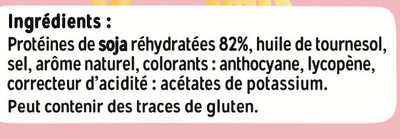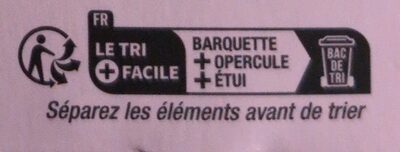Lardons végétaux Nature - La Vie - 2x75g
Barcode: 3770018078021 (EAN / EAN-13)
Common name: Allumettes végétales natures
Quantity: 2x75g
Packaging: Plastic, Fresh, fr:Etui en carton
Brands: La Vie, La Vie Foods, LaVie_Foods
Categories: Plant-based foods and beverages, Plant-based foods, Meats and their products, Meats, Meat alternatives, Meat analogues, Meat analogues from soy or wheat proteins, fr:Substituts des lardons, fr:Lardons-vegetariens
Labels, certifications, awards:
Vegetarian, Source of fibre, Source of proteins, Vegan, High proteins, Nutriscore, Nutriscore Grade C, Triman, fr:Soja-sans-ogm
Origin of ingredients: Unspecified
Manufacturing or processing places: France
Link to the product page on the official site of the producer: http://www.laviefoods.org
Stores: Carrefour
Countries where sold: France
Matching with your preferences
Report a problem
Data sources
Product added on by kiliweb
Last edit of product page on by raphael.
Product page also edited by casamence, elfisa, foodvisor, halyma, jeanne77foods, moon-rabbit, packbot, quechoisir, roboto-app, yuka.sY2b0xO6T85zoF3NwEKvlk9jfIHlsgD6Lgbgvk6W1M6MPob2Rs146JHoLKg, yuka.sY2b0xO6T85zoF3NwEKvlkBtYebf8g7oEDLVgmCn6oiVMsbReP9D84L7Pag, yuka.sY2b0xO6T85zoF3NwEKvlkNcb4Djmjj-B0PfuGqVmYrTKMbhWOt9xI7QFKs, yuka.sY2b0xO6T85zoF3NwEKvllJbSfP4r2jNDkLmoGek2NavNa7Da-1i44vcM6g, yuka.sY2b0xO6T85zoF3NwEKvllddDfvA8gKYNifnlUSp6PyQL4e5cfRO8oPWPKg, yuka.sY2b0xO6T85zoF3NwEKvlm1CVuvdnhLBaC7lmGGA_d2odLDLbshQ44zLN6s, yuka.sY2b0xO6T85zoF3NwEKvlnxKb8vDhSPBFhPjt1yH2fCVIbflPYxKvY72bao.
Last check of product page on by moon-rabbit.













